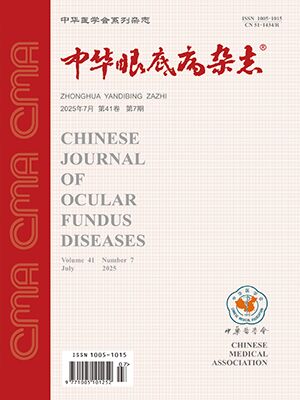| 1. |
田国红, 陈倩视盘水肿的鉴别及病因分析[J]. 中国眼耳鼻喉科杂志2017175378381. DOI: 10.14166/j.issn.1671-2420.2017.05.020..Tian GH, Chen QDiscrimination and etiology analysis of optic disc edema[J]. Chin J Ophthalmol and Otorhinolaryngol2017175378381. DOI: 10.14166/j.issn.1671-2420.2017.05.020.
|
| 2. |
Fraser JA, Sibony PA, Petzold A, et alPeripapillary hyper-reflective ovoid mass-like structure (PHOMS): an optical coherence tomography marker of axoplasmic stasis in the optic nerve head[J]. J Neuroophthalmol2021414431441. DOI: 10.1097/WNO.0000000000001203.
|
| 3. |
Mezad-Koursh D, Klein A, Rosenblatt A, et alPeripapillary hyperreflective ovoid mass-like structures—a novel entity as frequent cause of pseudopapilloedema in children[J]. Eye202035412281234. DOI: 10.1038/s41433-020-1067-x.
|
| 4. |
Freund P, Margolin E. Pseudopapilledema[M]. Treasure Island (FL): StatPearls Publishing, 2021.
|
| 5. |
Malmqvist L, Bursztyn L, Costello F, et alThe optic disc drusen studies consortium recommendations for diagnosis of optic disc drusen using optical coherence tomography[J]. J Neuroophthalmol2018383299307. DOI: 10.1097/WNO.0000000000000585.
|
| 6. |
Frisén LSwelling of the optic nerve head: a staging scheme[J]. J Neurol Neurosurg Psychiatry19824511318. DOI: 10.1136/jnnp.45.1.13.
|
| 7. |
Chang MY, Velez FG, Demer JL, et alAccuracy of diagnostic imaging modalities for classifying pediatric eyes as papilledema versus pseudopapilledema[J]. Ophthalmology20171241218391848. DOI: 10.1016/j.ophtha.2017.06.016.
|
| 8. |
Kovarik JJ, Doshi PN, Collinge JE, et alOutcome of pediatric patients referred for papilledema[J]. J AAPOS2015194344348. DOI: 10.1016/j.jaapos.2015.05.007.
|
| 9. |
Rebolleda G, Kawasaki A, de Juan V, et alOptical coherence tomography to differentiate papilledema from pseudopapilledema[J]. Curr Neurol Neurosci Rep2017171074. DOI: 10.1007/s11910-017-0790-6.
|
| 10. |
Wang DD, Leong JCY, Gale J, Wells APMultimodal imaging of buried optic nerve head drusen[J]. Eye (Lond)201832611451146. DOI: 10.1038/s41433-017-0009-8.
|
| 11. |
Pichi F, Romano S, Villani E, et alSpectral-domain optical coherence tomography findings in pediatric tilted disc syndrome[J]. Graefe's Arch Clin Exp Ophthalmol20142521016611667. DOI: 10.1007/s00417-014-2701-8.
|
| 12. |
Hamann S, Malmqvist L, Wegener M, et alYoung adults with anterior ischemic optic neuropathy: a multicenter optic disc drusen study[J]. Am J Ophthalmol2020217174181. DOI: 10.1016/j.ajo.2020.03.052.
|
| 13. |
Malmqvist L, Sibony PA, Fraser CL, et alPeripapillary ovoid hyperreflectivity in optic disc edema and pseudopapilledema[J]. Ophthalmology20181251016621664. DOI: 10.1016/j.ophtha.2018.04.036.
|
| 14. |
Petzold A, Coric D, Balk LJ, et alLongitudinal development of peripapillary hyper-reflective ovoid masslike structures suggests a novel pathological pathway in multiple sclerosis[J]. Ann Neurol2020882309319. DOI: 10.1002/ana.25782.
|
| 15. |
Ahn YJ, Park YY, Shin SYPeripapillary hyperreflective ovoid mass-like structures (PHOMS) in children[J]. Eye (Lond)2022363533539. DOI: 10.1038/s41433-021-01461-w.
|
| 16. |
Lyu IJ, Park KA, Oh SYAssociation between myopia and peripapillary hyperreflective ovoid mass-like structures in children[J]. Sci Rep20201012238. DOI: 10.1038/s41598-020-58829-3.
|
| 17. |
Lee KM, Woo SJ, Hwang JMMorphologic characteristics of optic nerve head drusen on spectral-domain optical coherence tomography[J]. Am J Ophthalmol2013155611391147. DOI: 10.1016/j.ajo.2013.01.024.
|
| 18. |
谭耀, 高玲视盘玻璃疣的研究现状及进展[J]. 中华眼底病杂志2020368648652. DOI: 10.3760/cma.j.cn511434-20181204-00414..Tan Y, Gao LOptic disc drusen: a review[J]. Chin J Ocul Fundus Dis2020368648652. DOI: 10.3760/cma.j.cn511434-20181204-00414.
|
| 19. |
Rotruck JA review of optic disc drusen in children[J]. Int Ophthalmol Clin20185846782. DOI: 10.1097/iio.0000000000000236.
|




